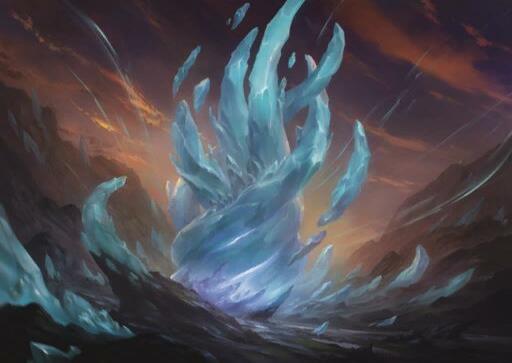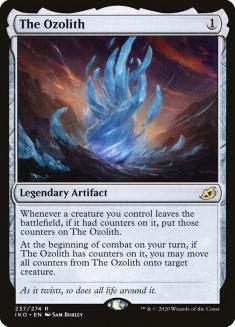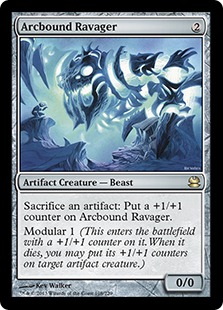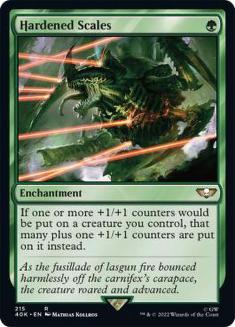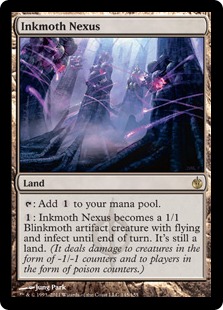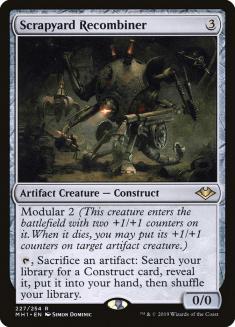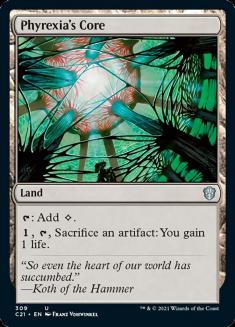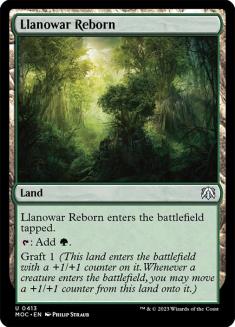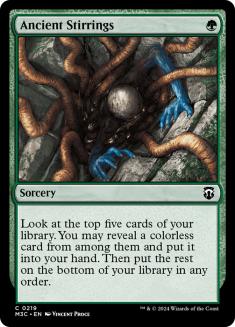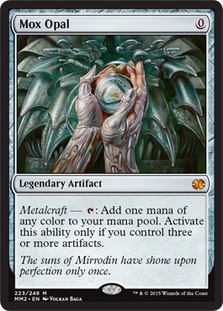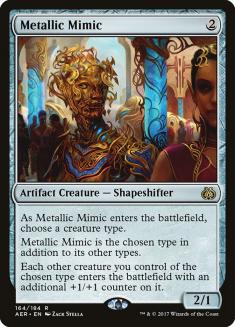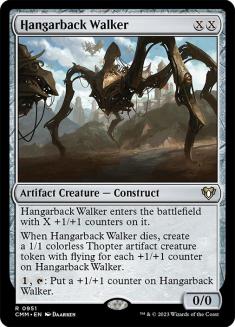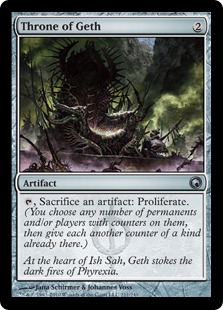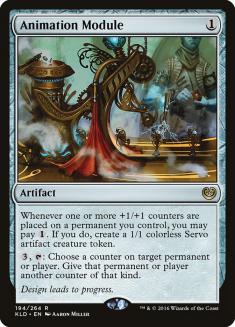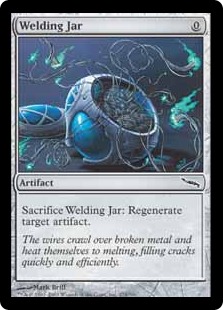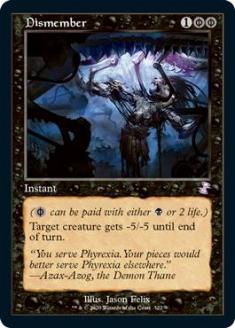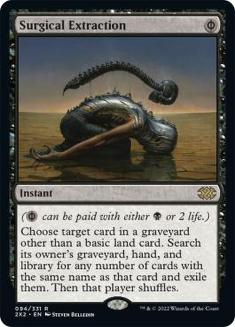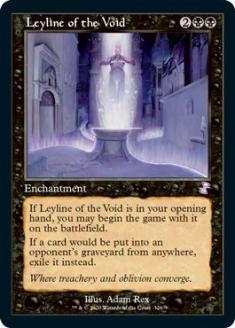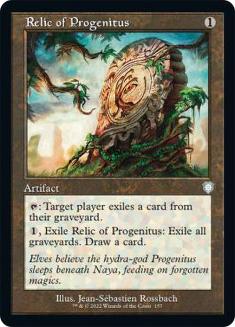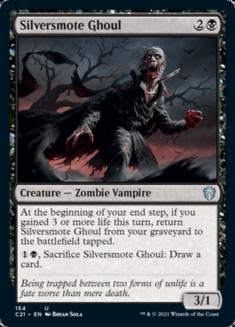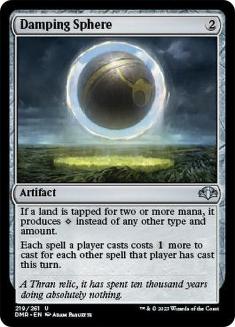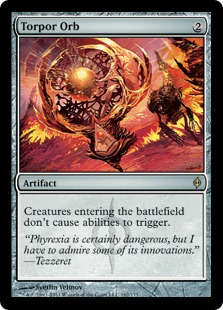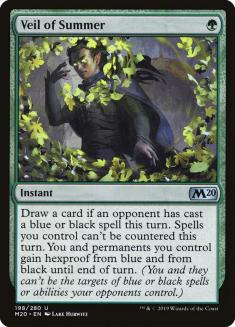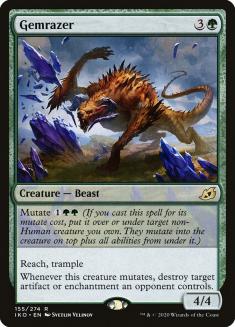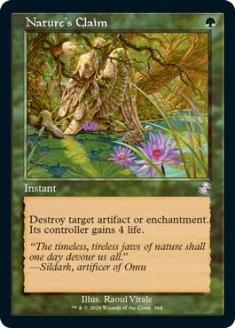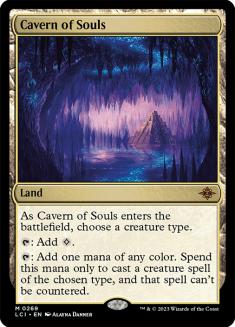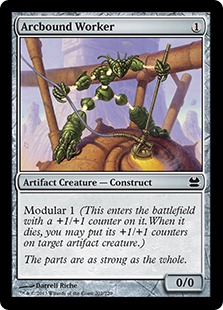Quick. Without doing the math, can you tell me how much damage this attacking Walking Ballista will do?

Probably enough, right?
People definitely said the words “The Ozolith is good in Hardened Scales” when Ikoria was released. But that was basically an irrelevant statement sidelined by others like “Companion — Each permanent card in your starting deck has converted mana cost 2 or less.”
Well, The Ozolith is pretty good in Hardened Scales.
Adapting for The Ozolith
The list best optimized for The Ozolith comes from Magic Online user kbr3.
Creatures (20)
Lands (24)
Spells (16)
Sideboard

Most of this deck will look familiar, but it’s good to refresh how the pieces interlock.
The general goal of Hardened Scales is to mix these pieces: something that doubly leverages +1/+1 counters like Inkmoth Nexus’s infect or the swing-plus-ping on Walking Ballista; a way to double your counters such as Hardened Scales; and a way to supply and spread counters on permanents like Arcbound Ravager, Throne of Geth, or the previously popular Steel Overseer. You don’t always need all three parts, but mixing and matching those is how you actually build the overwhelming synergies the deck has used to win games.
The Ozolith is mostly a counter doubler. You sacrifice a modular creature, it transfers over to Inkmoth Nexus and loads onto The Ozolith, and then everything shifts again. There isn’t a new threat that doubly leverages counters, so all the additions to Hardened Scales are mostly in the ways to supply counters.
We defined two steps to make The Ozolith do great work. You need your creatures to leave the battlefield at the time of your choosing, and ideally they would be modular creatures.
Scrapyard Recombiner is a natural fit for both sides and then some. Self-sacrificing comes up a decent amount, but it’s just as important to be able to find a Walking Ballista as your leverage card. Sadly Arcbound Ravager is a Beast so you can’t get your actual best card, but everything else is fair game.
Phyrexia’s Core is playing a similar role here, and it’s worth pointing out a lot of the changes to the deck are occurring in the manabase. There’s no Mox Opal, so there’s no Darksteel Citadel as a sort of Ancient Tomb. You get to leverage value out of a ton more lands, and Phyrexia’s Core went from being a fringe playable to solidly in the land section.
Maybe Llanowar Reborn is your “Ancient Tomb” these days. It “costs” a mana upfront to be tapped, but your curve is largely two-drop centric so missing a mana on Turn 1 or Turn 3 isn’t the end of the world. You then get refunded “two mana” on a graft trigger to Walking Ballista or Hangarback Walker, or really most of an Arcbound Worker if you are just moving it to an Arcbound Ravager. This borders on reading the text of the card, but I want to point out that Llanowar Reborn in more value than a Temple in this deck.
You get to play 24 lands because they are half spells themselves and a bunch of your spells are also mana sinks.
So why didn’t we see Llanowar Reborn before? Or why was it a debate?
I think it all comes down to spare mana math, colored sources, and Mox Opal. Hardened Scales was a notoriously mediocre Mox Opal deck due to the whole “everything costs two” issue. The traditionally broken Mox Opal starts involved jumping to two mana on Turn 1, basically impossible here with so few zero-cost artifacts, or three mana on Turn 2.
The latter was common, but you didn’t have one-drops that mattered. Or you did, but Hardened Scales as your last play was low-value. This added up to often having open green mana to fire off an Ancient Stirrings. You have less of both, so you have fewer spots to cleanly land an Ancient Stirrings, and it makes sense to spend green sources on the assured value of Llanowar Reborn.
That was also largely pre-London Mulligan unless you showed up to Mythic Championship Hogaak with Hardened Scales, and now you can just get a free Ancient Stirrings via a mulligan. It was also pre-Veil of Summer taxing your green sources into the mid-game.
But The Ozolith is yet another good colorless payoff to find and Arcbound Ravager is still your second-best card. I’m not convinced that Ancient Stirrings shouldn’t be in the deck. You aren’t even legally obligated to play four of it, so finding room among these Animation Modules and other nonsense seems easy enough. You probably have to sacrifice some Cavern of Souls, which is a real cost given Simic-based Uro, Titan of Nature’s Wrath / Cryptic Command decks are still among the best things to do in the format, but Ancient Stirrings is a way to find those Caverns too, right?
The other omission is Metallic Mimic, but I think the real commentary here is on Hangarback Walker. Metallic Mimic’s primary goal is to let you curve Hardened Scales into a bunch of 2/2 double-X-costed things. Ignoring that Llanowar Reborn overlaps with Turn 1 Hardened Scales, I think the problem with Metallic Mimic is that I don’t even know if I want four copies of Hangarback Walker.
Some of that may also link back to Ancient Stirrings. Hangarback Walker’s main job is being worth a million damage with Arcbound Ravager, and without Ancient Stirrings you just have fewer Arcbound Ravagers. Throne of Geth doesn’t turn Thopter tokens into damage, and you can choose your favorite insult to describe playing Steel Overseer in 2020 London Mulligan Modern. Right now Hangarback Walker is just the worst card that is good enough to make your deck since you want more creatures, and playing more bad cards to make it slightly less bad to draw both is throwing away good value.
Metallic Mimic tricks you into playing more bad cards to support it and isn’t good in multiples.
That leaves three cards I haven’t discussed, and I may as well complete the full sweep at this point.
Throne of Geth went from being one of the worst cards in Hardened Scales, often a convoluted win-more, to one of your best with The Ozolith and the adaptations to it. Much like modular counters moving prior to Throne of Geth’s activation resolving, The Ozolith picks up counters from the sacrifice in response as well. There are just tons of ways to get three or more power per activation and the sacrifice is inherently beneficial instead of costing valuable resources. My instinct is to add a third copy of this card.
Animation Module on the other hand got much worse. You are less of an Arcbound Ravager deck, so it is less of a crucial combo piece.
Odd-oliths and Ends
If you haven’t played Hardened Scales before, feel free to peruse some of the basic math from when the deck first broke out.
The first rule to remember: if you are ever starting to accumulate counters in multiple shots with a Hardened Scales, it’s often more than you think and often probably enough. If you have Hardened Scales and Arcbound Ravager, it’s hard not to deal twenty damage. Moving a counter via modular gets a bonus. Or graft. Or proliferate. Or basically anything.
Hardened Scales does not add an extra counter to The Ozolith when it picks up +1/+1 counters since it isn’t a creature, but it does add a bonus counter when The Ozolith’s combat trigger resolves and moves those over to something else.
The Ozolith gets counters from creatures leaving the battlefield for any reason. If your opponent Path to Exiles a Walking Ballista, you get the counters and probably don’t want to spend them just on pings. If your Hangarback Walker gets Flickerwisped? Counters on The Ozolith.
The Ozolith picks up all counters on your dying creatures. That includes -1/-1 counters. It can target opposing creatures. Those do cancel out +1/+1 counters stored on it, so don’t lose counters that way, but if you do something like block Glistener Elf and get hit with a pump spell, you could end up with -1/-1 counters and a floating removal spell on your The Ozolith.
The presence of The Ozolith and more ways to load up a Walking Ballista make you want a non-summoning sick Ballista more often than you previously wanted in this deck. Move that card a bit forward in your sequencing.
Scrapyard Recombiner works at instant speed and can sacrifice things in combat, in response to removal spells, and so on. It can also eat spare Nexuses and is the only real argument for having any Darksteel Citadels in your deck. It isn’t a good argument, but you could do it.
Scrapyard Recombiner chains open up one good math kill with Inkmoth Nexus and Llanowar Reborn. On Turn 4, cast Scrapyard Recombiner and graft it to a 3/3. On Turn 5, play a fifth land, animate Nexus, and flip Scrapyard Recombiner into another one you cast. The first modular puts three counters on Inkmoth Nexus for a 4/4 hit, and then the next turn the second Scrapyard Recombiner makes that a 6/6 for lethal poison. These two-attack Inkmoth Nexus kills are Arcbound Ravager deck’s bread-and-butter, so don’t miss them.
You can proliferate your opponent’s cards with Throne of Geth. Aether Vial is the most common card to mess with and you can even respond to an Aether Vial activation to change the value it is activating for. Other things to look for are Chalice of the Void, Blast Zone, Engineered Explosives (but not in response to the activation), and people from seven years ago showing up with Kitchen Finks.
What’s in a Sideboard? What’s in a Modern?
It’s kinda hard to tell what should even be in the sideboard of this deck, since no one really knows what Modern exactly looks like after the Arcum’s Astrolabe ban, but I think there are some safe guesses to take.
The stock Dismembers are a no-brainer. The reach of that card in Modern – good against Humans, Amulet ramp creatures, and midrange creatures, plus covering Collector Ouphe – is too much to pass up.
When selecting effects for a Hardened Scales sideboard, err on the side of the slam-dunk game-breaker and not the utility card. This is just linear sideboarding 101, but Hardened Scales is also not inherently faster than the combo decks of Modern the way Affinity was. You can’t steal a game with a Spell Pierce and a free turn, but you sure can steal a game with the right hate card.
If you end up not playing Ancient Stirrings, I would also consider some of the non-artifact options for these slots. The deck played colorless cards in the past to cantrip into them and protect them with Welding Jar, and because the mana is sketchy, not because you are sacrificing them to Arcbound Ravager. If you don’t have cantrips, the hate card doesn’t need to be saved from Fatal Push or Shenanigans, and you can cast it, why does it have to be an artifact?
You want some graveyard hate, possibly more than is here in kbr3’s list. Dredge got a significant upgrade with Silversmote Ghoul in Core Set 2021, just giving the deck more combinations of dredges that produce quickly lethal power since it is now limited in how well it churns cards without Faithless Looting.
You need a decent amount of that hate to come at good value since you need it to combat Uro, Titan of Nature’s Wrath and Mystic Sanctuary from that sector of the metagame, since both cards will crush you in a long game. The three copies of Relic of Progenitus are a lock, but I wouldn’t mind a Grafdigger’s Cage or two.
Tron players don’t stop, and neither does Caleb Scherer. More than zero Damping Sphere sounds good. Replace those with Primeval Titan and Champion of the Parish and you round up Torpor Orb as well.
I’m unsure how many copies of Veil of Summer I want at this point. Take your direction from the quantities of Death’s Shadow and Archmage’s Charm in the metagame, the latter of which is an absolute nightmare.
Gemrazer makes sense against exactly Karn, the Great Creator as a way to clear Ensnaring Bridge and battle down the planeswalker. I’m unsure how winnable that situation is most of the time and why I’m playing Hardened Scales if I expect tons of Karn, but that’s why it’s there. Losing Nature’s Claim is a real cost against Boros Burn, where you would cast the card both to kill Eidolon of the Great Revel and to gain four life. I would lean towards playing neither right now.
Putting it all together, I’m trying this list right now.
Creatures (18)
Lands (24)
Spells (18)
Sideboard

Sideboard Guide
VS Uro, Titan of Nature’s Wrath Midrange
You need to be more aggressive than against past midrange decks due to Mystic Sanctuary locks. Your goal is to get enough chip damage that you can set up an end-game fork where if they kill one thing you sacrifice it and the counters load up something else, or if they Cryptic Command to tap your creatures you have a Nexus to activate for lethal. If you aren’t close to that, don’t be afraid to shoot your shot on a big push if you have half an opening.
Out:
In:
VS Thoughtseize Midrange (Jund or Death’s Shadow)
Here you can and should be a bit more careful. Games end because eventually they run out of answers or get choked on mana to deploy them. Force them to keep throwing out answers, and don’t spew value on modular or similar effects on trades if you can help it.
Out:
In:
Relic of Progenitus is also in range if your opponent has a game-dominating graveyard threat like Lurrus of the Dream-Den, and the last Dismember also can come in if their threats aren’t diversified to planeswalkers. There’s also a chance this is too many copies of Veil of Summer since the card is purely reactive, but it’s easy to convert for value and basically every game comes down to them trying to make those exchanges.
VS Humans and Other Aether Vial Decks
This is just a race to you getting counters on Walking Ballista or them getting stuff out of range.
Out:
In:
The cards I’m cutting here against Humans are specifically bad against Reflector Mage and Deputy of Detention. Welding Jar specifically may vary in quality. Hangarback Walker is worse than you would think against all these decks since they go so large.
VS Mono-Red Prowess
You shouldn’t be chump blocking until the point where you are accumulating real value each turn, at which point you want to figure out how to lock everything up. Soul-Scar Mage is another way The Ozolith can get -1/-1 counters to redistribute.
Hangarback Walker with -1/-1 counters is weird. If you have a 4/4 Hangarback Walker and they Soul-Scar Mage Lightning Bolt it, you end up with a 1/1 Hangarback Walker since the -1/-1 and +1/+1 counters cancel out. If you have a 3/3 Hangarback Walker in the same scenario, it would die and you would get three Thopters, since it checks what was going on right before it died.
Out:
In:
Unlike Burn, Prowess needs to accumulate damage with creatures to win most games. You gain life by Dismembering their Monastery Swiftspear.

